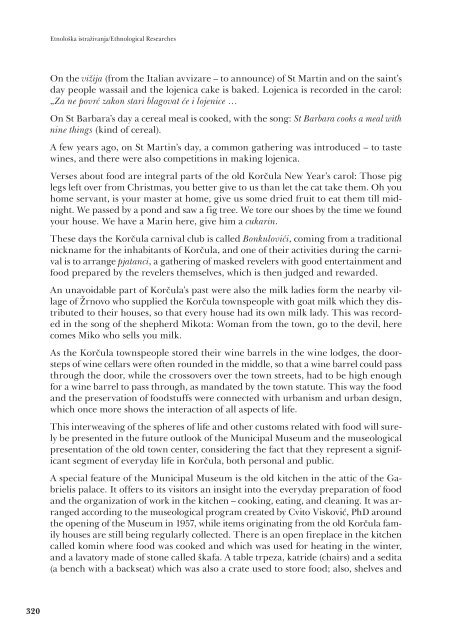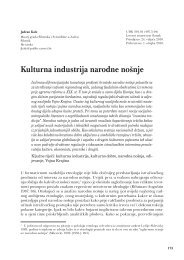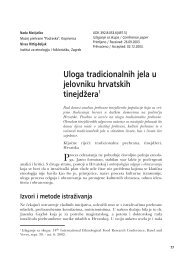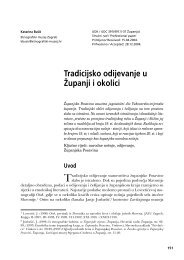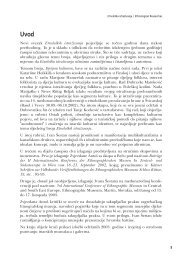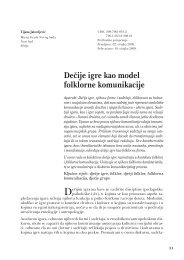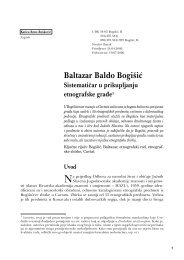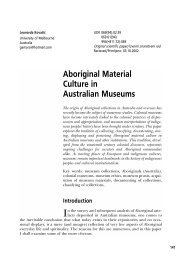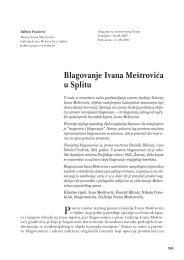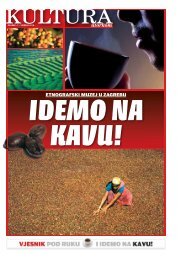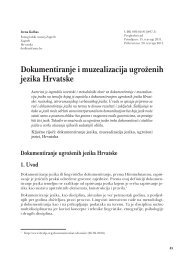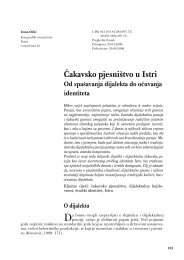U kuhinji i za stolom korÄulanske graÄanske obitelji â poticaj ... - EMZ
U kuhinji i za stolom korÄulanske graÄanske obitelji â poticaj ... - EMZ
U kuhinji i za stolom korÄulanske graÄanske obitelji â poticaj ... - EMZ
You also want an ePaper? Increase the reach of your titles
YUMPU automatically turns print PDFs into web optimized ePapers that Google loves.
Etnološka istraživanja/Ethnological Researches<br />
On the vižija (from the Italian avvi<strong>za</strong>re – to announce) of St Martin and on the saint’s<br />
day people wassail and the lojenica cake is baked. Lojenica is recorded in the carol:<br />
„Za ne povrć <strong>za</strong>kon stari blagovat će i lojenice …<br />
On St Barbara’s day a cereal meal is cooked, with the song: St Barbara cooks a meal with<br />
nine things (kind of cereal).<br />
A few years ago, on St Martin’s day, a common gathering was introduced – to taste<br />
wines, and there were also competitions in making lojenica.<br />
Verses about food are integral parts of the old Korčula New Year’s carol: Those pig<br />
legs left over from Christmas, you better give to us than let the cat take them. Oh you<br />
home servant, is your master at home, give us some dried fruit to eat them till midnight.<br />
We passed by a pond and saw a fig tree. We tore our shoes by the time we found<br />
your house. We have a Marin here, give him a cukarin.<br />
These days the Korčula carnival club is called Bonkulovići, coming from a traditional<br />
nickname for the inhabitants of Korčula, and one of their activities during the carnival<br />
is to arrange pjatanci, a gathering of masked revelers with good entertainment and<br />
food prepared by the revelers themselves, which is then judged and rewarded.<br />
An unavoidable part of Korčula’s past were also the milk ladies form the nearby village<br />
of Žrnovo who supplied the Korčula townspeople with goat milk which they distributed<br />
to their houses, so that every house had its own milk lady. This was recorded<br />
in the song of the shepherd Mikota: Woman from the town, go to the devil, here<br />
comes Miko who sells you milk.<br />
As the Korčula townspeople stored their wine barrels in the wine lodges, the doorsteps<br />
of wine cellars were often rounded in the middle, so that a wine barrel could pass<br />
through the door, while the crossovers over the town streets, had to be high enough<br />
for a wine barrel to pass through, as mandated by the town statute. This way the food<br />
and the preservation of foodstuffs were connected with urbanism and urban design,<br />
which once more shows the interaction of all aspects of life.<br />
This interweaving of the spheres of life and other customs related with food will surely<br />
be presented in the future outlook of the Municipal Museum and the museological<br />
presentation of the old town center, considering the fact that they represent a significant<br />
segment of everyday life in Korčula, both personal and public.<br />
A special feature of the Municipal Museum is the old kitchen in the attic of the Gabrielis<br />
palace. It offers to its visitors an insight into the everyday preparation of food<br />
and the organi<strong>za</strong>tion of work in the kitchen – cooking, eating, and cleaning. It was arranged<br />
according to the museological program created by Cvito Visković, PhD around<br />
the opening of the Museum in 1957, while items originating from the old Korčula family<br />
houses are still being regularly collected. There is an open fireplace in the kitchen<br />
called komin where food was cooked and which was used for heating in the winter,<br />
and a lavatory made of stone called škafa. A table trpe<strong>za</strong>, katride (chairs) and a sedita<br />
(a bench with a backseat) which was also a crate used to store food; also, shelves and<br />
320


